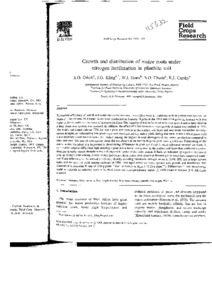| dc.contributor.author | Oikeh, S. |
| dc.contributor.author | Kling, J. |
| dc.contributor.author | Horst, W. |
| dc.contributor.author | Chude, V. |
| dc.contributor.author | Carsky, R. |
| dc.date.accessioned | 2019-12-04T11:21:03Z |
| dc.date.available | 2019-12-04T11:21:03Z |
| dc.date.issued | 1999 |
| dc.identifier.citation | Oikeh, S., Kling, J., Horst, W., Chude, V. & Carsky, R. (1999). Growth and distribution of maize roots under nitrogen fertilization in plinthite soil. Field Crops Research, 62(1), 1-13. |
| dc.identifier.uri | https://hdl.handle.net/20.500.12478/3645 |
| dc.description.abstract | To improve efficiency of soil N and water use in the savanna, maize (Zea mays L.) cultivars with improved root systems are required. Two rainfed field experiments were conducted in Samaru, Nigeria in the 1993 and 1994 growing seasons with five maize cultivars under various rates of nitrogen fertilizer. The capacity of maize for rapid early root growth and to later develop a deep, dense root system was assessed. In addition, the effect of N fertilization on root growth of maize was studied in 1994. The widely cultivated cultivar TZB-SR had a poor root system in the surface soil layer and was more susceptible to early-season drought, as indicated by low plant vigor and aboveground dry matter yield during that time. It had a lower grain yield and a relatively small harvest index, but ranked among the highest in total aboveground dry matter production compared to other cultivars. The size of root system alone did not always relate well with grain yield among cultivars. Partitioning of dry matter within the plant was important in determining differences in grain yield and N stress tolerance between cultivars. A semiprolific cultivar (SPL) had high seedling vigour and a dense root system in the surface soil layer that conferred a greater tolerance to early-season drought stress and improved uptake of the early-season N flush, as indicated by a greater dry matter yield at 35 days after sowing (DAS). It also had a fine, deep, dense root system at flowering that could have improved water- and N-use efficiency in the subsoil (> 45 cm), thereby avoiding midseason drought stress in 1994. SPL had a large harvest index and the greatest yield among cultivars in 1994. Averaged across cultivars, greater root growth and distribution was observed at a moderate N rate of 0.56 g plant−1 than at zero-N or high N (2.26 g plant−1). Differences in root morphology could be valuable as selection criteria for N-efficient and drought-tolerant maize. |
| dc.description.sponsorship | Deutsche Gesellschaft für Internationale Zusammenarbeit |
| dc.language.iso | en |
| dc.subject | Nitrogen |
| dc.subject | Moist Savanna |
| dc.subject | Root Length Density |
| dc.subject | Root Mass Density |
| dc.subject | Specific Root Length |
| dc.subject | Plinthite |
| dc.subject | Farmers |
| dc.subject | Markets |
| dc.subject | Drought Stress |
| dc.subject | N Fertilization |
| dc.subject | Maize Cultivars |
| dc.title | Growth and distribution of maize roots under nitrogen fertilization in plinthite soil |
| dc.type | Journal Article |
| dc.description.version | Peer Review |
| cg.contributor.affiliation | International Institute of Tropical Agriculture |
| cg.contributor.affiliation | Universität Hannover |
| cg.contributor.affiliation | Ahmadu Bello University |
| cg.coverage.region | Africa |
| cg.coverage.region | Acp |
| cg.coverage.region | West Africa |
| cg.coverage.region | Europe |
| cg.coverage.country | Nigeria |
| cg.coverage.country | Germany |
| cg.isijournal | ISI Journal |
| cg.authorship.types | CGIAR and developing country institute |
| cg.iitasubject | Smallholder Farmers |
| cg.iitasubject | Plant Diseases |
| cg.iitasubject | Pests Of Plants |
| cg.iitasubject | Plant Breeding |
| cg.iitasubject | Plant Production |
| cg.iitasubject | Farm Management |
| cg.iitasubject | Food Security |
| cg.iitasubject | Markets |
| cg.iitasubject | Genetic Improvement |
| cg.iitasubject | Agribusiness |
| cg.iitasubject | Plant Genetic Resources |
| cg.iitasubject | Domestic Trade |
| cg.iitasubject | Livelihoods |
| cg.iitasubject | Soil Fertility |
| cg.iitasubject | Soil Information |
| cg.iitasubject | Soil Health |
| cg.accessibilitystatus | Limited Access |
| local.dspaceid | 95800 |
| cg.identifier.doi | https://doi.org/10.1016/S0378-4290(98)00169-5 |

